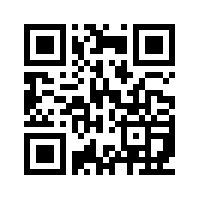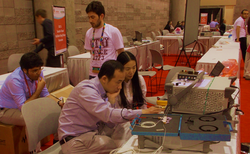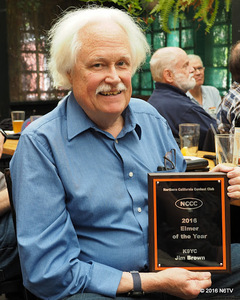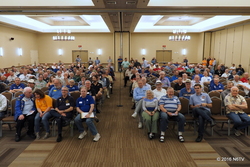 May 4, 2016 Editor: Paul Bourque, N1SFE | |||||
IN THIS ISSUE
Four big QSO Parties are this weekend, representing sixteen states. If you're participating as a station located in New England, the seventh call area, Delaware, or Indiana, give out your county and state, using the appropriate abbreviation for your county. Outside-of-QSO-party-area-stations provide their state, or if they're DX, their country. Most QSO Parties encourage mobile or temporary operation from lesser-populated counties. If the bands are open, it may even be possible to get some new UHF or VHF grid squares. It always helps to read the rules, and visit the websites of the contests. Some, like the 7QP, publish a list of planned activations. When you work a station set up on a county line, you'll need to be able to log multiple counties, quickly. Your logging program may have some features to help you do this, or even more advanced QSO Party tricks. See your logger's documentation. N1MM Logger+ has a whole section on QSO Party operation. N3FJP provides different logging programs for different QSO Parties. If QRP and hand-generated CW using a straight key, sideswiper, or bug are more your fancy, the SKCC Weekend Sprintathon is where you'll want to be. Check the rules for the power-based scoring details. The next weekend features Arkansas's QSO Party, or if you enjoy earning multipliers during a contest, in the MARAC contest there are 3077 different multipliers - one for each county. It's the beginning of the VHF season, and six meters is wonderful when it's open. And it COULD be during the Spring 50 MHz Sprint. Openings can come and go as Sporadic E-clouds form, move, and dissipate. There are a number of websites that consolidate spots and report on VHF activity, here's just one from dxmaps.com. BULLETINS
The ARRL Contest Advisory Committee is studying how to get more young people involved in contesting, and is inviting everyone, especially young people, hams or not, to take their Youth in Amateur Radiosport survey. Please spread the word about the survey among your friends, ham radio clubs and your local schools. Go to this link to take the survey: tinyurl.com/YouthHamRadio For more information contact K5KG@arrl.net
If you're a professional attending the 2016 International Microwave Symposium (IMS) conference in San Francisco, you are probably keenly aware of the importance of finding engineering graduates with practical experience. The ARRL will have a presence at IMS and it could directly benefit you and your company. The League's theme for this year is to gather ideas from industry professionals about how to encourage students and educators to participate in Amateur Radio as a means of personal and professional development. Companies hire hams because they have practical experience with RF and communications systems, standing out from other students. How can we spread the word? Come say hello and contribute your thoughts. Have a little free time? The ARRL is also seeking volunteers at the booth in "University Row" to talk with show attendees, students, educators, and other interested people - contact Ward, N0AX for more information. BUSTED QSOS All quiet last time. Complete information for all contests follows the Conversation section May 5 May 6 May 7
May 8 May 11 May 12 May 13 May 14
May 15 May 16 May 18 Hold the date: The Pacific Northwest VHF Society will hold it's 2016 conference at the Shilo Inn in Bend, Oregon, on October 7-8, 2016. As in the past, the format will include Friday afternoon activities, and activities all of Saturday. As more information becomes available it will be on the PNWVHFS website. (Jim, K7ND, via PNWVHFS reflector) DX Engineering has brought back an old favorite, the clear glass antenna insulator for wire antennas. Furthermore, Spanish maker EAntenna Yagi and Dipole antennas are now available from DX Engineering. LED Lighting continues it's practical advance. At the local home store, you can buy four foot long LED lights which replace conventional fluorescent fixtures of that size. In addition to having greater light output and lower power consumption, Tony, N2TK, reports on the RFI reflector that the fixtures he's tried are RFI-free in the ham bands. (RFI Reflector) Some RTTY Contesters also chase DX. If that describes you, click on over to the "2016 Digital Mode Most Wanted Survey," previously known as "RTTY Most Needed DXCC Entities Survey." According to the survey team consisting of Don, AA5AU, Ed, W0YK, and Larry, K8UT, "these surveys help DXpedition planners and are of interest to all digital operators." Results from years past are available via AA5AU's website. The team is also working to obtain most-wanted statistical information from other sources like ClubLog. (RTTY mailing list) N3FJP has released a new version of his AC Log program. In addition, all of his contest logging programs have been released with improvements including API support. See the N3FJP website for more details. While touch screens are already starting to be incorporated into ham gear, their use continues to be discussed and debated. This article from EE Times discusses some of the practical considerations of using touch screens in an automotive environment, which shares with contesting similar issues of potential electrical noise and operator focus. Latency: the delay from an input to a system to an output from that same system. For example, some RTTY decoders may be more accurate in noisy conditions, but make take as long as one to three character times to spit out a decoded character.
Jim Brown K9YC was honored with the Northern California Contest Club (NCCC) "Elmer of the Year" award on April 23, 2016. Even if you're not part of NCCC, you'll likely be familiar with Jim's extensive electronic presence on various ham-related mailing lists, and through his contributions to various publications. Jim keeps his own list of publications on his website.
At the recent International DX Convention, held in Visalia, California, Ward, N0AX, was the moderator of the contest forum, which included N6TV, N6MJ, and N2IC. Ward encouraged opening statements, and Bob, N6TV led with the assertion that for Single Operators, a waterfall display is becoming a necessity and that our overall our community needs to better deter cheating, especially remote receivers and transmitters. Dan, N6MJ, posited that the minimum bar for competitive multi-single categories requires additional in-band radios, while dueling CQ is going to be the leading edge among single ops. Steve, N2IC, one of the major contributors to the N1MM Logger+ project, wanted to see more communication and control standardization of equipment that we use in our stations. "The World Wide Radio Operators Foundation (WWROF) is pleased to present Tim Duffy, K3LR, and a look at contest activities at Dayton 2016. You can view the short video at http://wwrof.org/webinar-archive/dayton-2016-contest-activities/" (K4ZW via CQ-Contest) Here's an amateur radio music video from Andrew, OZ5E and Lissa of the HamBand! Andrew and his wife Lissa have recorded an entire CD of songs about amateur radio. Though drawing upon various musical styles ranging from C&W "The Radio Widow" to the more Rock-n-Roll style of "The Contest," you'll find a solid country-folk orientation to these tunes. The article for the final results of the 2015 ARRL Phone Sweepstakes (PDF) are now on the ARRL web site. If you're looking for inspiration for this year's Sweepstakes, read about the all-youth ham led multi-operator effort by Marty, KC1CWF, Ken, KC1AHI, and Nathan, KB1RD operating as KC1ENE. WRTC-2018 standings continue to be updated on the WRTC-2018 website. Here's a mobile operating tip from Bill, AC0W: If you're operating mobile and you find that your whip antennas are not staying at the correct length because of slipping set screws, instead of using a thread-locking type of compound, you could use a knurled cup point set screw, which will bite better than normal set screws. This will allow easier intentional adjustment. They are available from McMaster-Carr, Grainger, and other vendors. Jim, AD1C, has written an ADIF File splitter, to 'burst' a single file into multiple files based on transmitted QTH. Each of these sub-files can be signed and uploaded to LoTW using a different station location. He's tested it with N1MM and WriteLog - see his website for more information and support for other loggers. Many amateur radio projects are incorporating Arduino-compatible computing elements, and these gems are available in many different variations and sizes. A new AA-battery sized Arduino board has just been developed. This could be a nice way to add additional functionality into an existing piece of equipment. By using an EEG to analyze brain activity while presented with a standardized sets of images, humans can be differentiated from one another with 100% accuracy. As it's not yet available commercially, we still have to remember to type "OPON" for the foreseeable future. Computers keep getting faster and faster, and smaller and smaller, but there's a theoretical limit to how fast a computer can ever be, based on E=mc^2, and the Heisenberg uncertainty principle. This is Bremermann's limit. Could an effective DSP module to completely remove grow light noise ever be implemented in hardware weighing less than a 3AG fuse? Knowing the complexity of the algorithm, and the mass of the fuse, Bremermann's can provide a back-of-the-envelope check for infeasibility. The characteristics of the "impossible" EM Drive, also known as the 'resonant cavity thruster,' which uses microwaves to seemingly accelerate a spacecraft, have been linked to the already observed "fly-by anomaly" in this Technology Review article. Here are three sisters who 'contest' by writing computer code. And they win. An accidental discovery at the University of California at Irvine involving conductive nanowires with special coatings may end up dramatically increasing the number of battery charge/discharge cycles. Wow So, where is it? You know. The "Wow" factor. Back in the golden days of Ham Radio, just before and continuing to a couple of years after we got our licenses... when mystery, adventure, small joys were ours for a time investment. When trying to make a contact using a radio, some wire and some electricity, and finally somebody answered our call? What we were able to accomplish compared to everyone else was admirable, and exciting. It's what got us into the hobby. Maybe careers. The "Wow" factor. It's the thing we try to explain to young people, to get them interested in the hobby, when they're not playing a game on the their cellular phone. Or texting. Young people don't seem to see the Wow in Amateur Radio. What year did we as a hobby lose the Wow? I don't think it was all at once. Some Wow might have been lost as electronics got miniaturized, and we could walk around with our tunes. Wayne Greene, W2NSD, not content with 73 magazine, did too good a job starting Byte magazine, and computers started down the path to be micro-sized, more powerful, and consumer oriented. He had help over time, certainly, but he was standing alone in September, 1975. Lots of hams worked in the computer industry, too. Computers leaked a lot Wow. Our wait-your-turn-to-talk repeaters certainly became less crowded as 'regular folk' could talk on increasingly cheaper mobile telephones. Many hams were involved in the consumer electronics and cellular phone industry, because who knew best about this RF stuff? While we contesters found computers great for things like logging without duplicates, controlling our radios, helping to design our next project, normal people were using computers to manage their recipes (perhaps you're of a certain age to get that joke), playing games, and pretty much everything they could. 10 - Computers made communications cheaper, which was good for hooking up more computers, which meant communications became cheaper. GOTO 10. To everyone, the Internet became something, and it also became their communications spectrum. In effect, we were generous, and we shared our Wow. Everyone could have some of our Wow by buying it baked into consumer products and services, and most didn't even recognize it. How can they understand and appreciate our hobby, how challenging it can be and was, how rewarding it is overcoming challenges, when they don't appreciate the Wow they use every day? To today's youth, the Internet has always been "ON." I like to think I recognize some of the Wows we have in Amateur Radio today. There's definite Wow in the rates of single operator multiple-radio efforts going full-bore, for hours on end. In the contest score records that are broken with regularity. In having a QSO where the signals aren't humanly discernable, and working via the moon with 100 watts. In having reliable equipment that looks and performs better and cost less than ever (adjusted for today's dollars). In seeing a graphical depiction of wide swaths of RF spectrum, with signals decoded and labeled automatically. In getting a real signal report simultaneously from multiple spots on the globe through an autonomous distributed signal reporting network. What will be tomorrow's Wows? Automated "Contest Mentors" that can help you be a better operator? Instant public contest log scoring using distributed ledgers or blockchains? Even better power efficiency and smaller sizes with smarter gain blocks? Radically new designs for gain antennas? Communication via quantum effects? Wow is a renewable resource. It's what we create and look for to make our stations better and our rates higher, and what helps to continue to attract new people with new ideas to our hobby.
That's all for this time. Remember to send contesting related ephemera, book reviews, tips, techniques, press releases, errata, club information, pictures, stories, blog links, predictions, and Wow sightings to contest-update@arrl.org 73, CU in Dayton, Brian N9ADG 5 May - 18 May 2016 An expanded, downloadable version of QST's Contest Corral in PDF format is available. Check the sponsor's Web site for information on operating time restrictions and other instructions. HF CONTESTS CWops Mini-CWT Test, May 5, 0300z to May 5, 0400z; CW; Bands: 160, 80, 40, 20, 15, 10m; Member: Name + Member No., non-Member: Name + (state/province/country); Logs due: May 7. VHF+ CONTESTS Microwave Spring Sprint, May 7, 0800z to May 7, 1400z; not specified; Bands: All above 902 MHz; 6-character grid square; Logs due: May 21.
Also, see Arkansas, Delaware, and Seventh-Area QSO parties, SKCC Sprintathon, above. 5 May - 18 May 2016 May 5, 2016 May 6, 2016 May 7, 2016 May 8, 2016 May 9, 2016 May 10, 2016 May 11, 2016 May 14, 2016 May 15, 2016
May 16, 2016 May 17, 2016 ARRL Information Click here to advertise in this newsletter, space subject to availability. Your One-Stop Resource for Amateur Radio News and Information ARRL membership includes QST, Amateur Radio's most popular and informative journal, delivered to your mailbox each month. Subscribe to NCJ - the National Contest Journal. Published bimonthly, features articles by top contesters, letters, hints, statistics, scores, NA Sprint and QSO Parties. Subscribe to QEX - A Forum for Communications Experimenters. Published bimonthly, features technical articles, construction projects, columns and other items of interest to radio amateurs and communications professionals. Free of charge to ARRL members: Subscribe to The ARRL Letter (weekly digest of news and information), the ARES E-Letter (monthly public service and emergency communications news), Division and Section news -- and much more! ARRL offers a wide array of products to enhance your enjoyment of Amateur Radio. Visit the site often for new publications, specials and sales. Donate to the fund of your choice -- support programs not funded by member dues! Reprint permission can be obtained by sending email to permission@arrl.org with a description of the material and the reprint publication. ACKNOWLEDGEMENTS ARRL Contest Update wishes to acknowledge information from WA7BNM's Contest Calendar and SM3CER's Contest Calendar. | |||||










